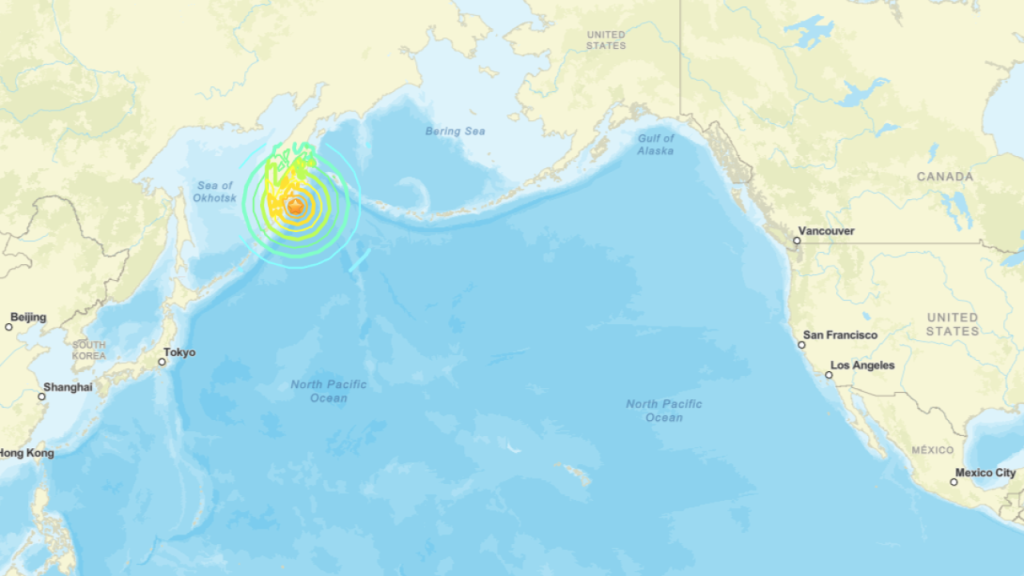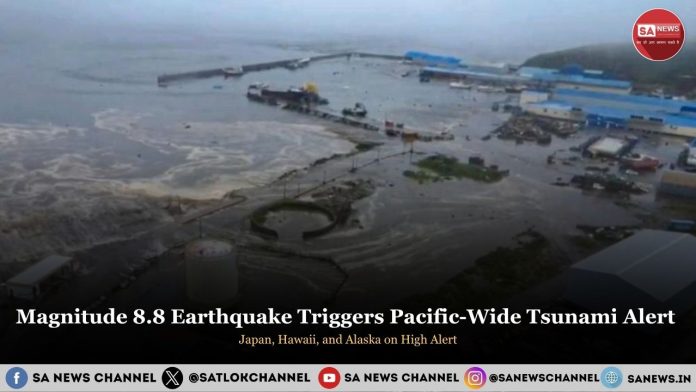Tsunami Alert: On July 30, 2025, a devastating magnitude 8.8 earthquake struck near Russia’s Kamchatka Peninsula, triggering widespread tsunami warnings across the Pacific Ocean. The shallow-depth quake, initially reported as magnitude 8.7 before being revised upward by the USGS, has prompted emergency evacuations affecting over 900,000 people across Japan, Hawaii, Alaska, and the U.S. West Coast.
This seismic event marks the strongest earthquake in the region since 1952, generating tsunami waves that reached up to 4 meters in Russia’s Severo-Kurilsk and prompting coordinated international emergency responses across the Pacific Rim.
Tsunami Alert : Immediate Impact in Russia’s Kamchatka Region
The earthquake’s epicenter, located at a shallow depth of approximately 19 kilometers near the Kamchatka Peninsula, generated immediate and severe impacts in the closest populated areas. Severo-Kurilsk experienced the most significant tsunami impact, with waves reaching up to 4 meters in height, causing substantial infrastructure damage
Critical facilities suffered direct hits, including a local kindergarten and airport terminal. Despite the extensive property damage, Russian authorities reported several injuries but thankfully no fatalities in the immediate aftermath – The Guardian. The rapid response and evacuation procedures implemented in Severo-Kurilsk proved crucial in preventing loss of life despite the tsunami’s destructive power.
Japan’s Comprehensive Emergency Response
Nationwide Tsunami Warnings and Mass Evacuations
The Japan Meteorological Agency (JMA) swiftly activated comprehensive tsunami protocols, issuing tsunami advisories and warnings across Japan’s Pacific coast, including Hokkaido, Honshu, and Kyushu – The Japan Times. Initial wave height predictions of up to 1 meter were subsequently revised upward to 3 meters in certain coastal zones as the situation developed – The Japan Times.
Japanese authorities demonstrated their refined disaster preparedness by ordering evacuations for over 900,000 people across 133 municipalities – The Guardian. This massive mobilization reflects lessons learned from previous megathrust events and showcases Japan’s advanced tsunami early warning systems.
Nuclear Safety Precautions
The Fukushima Daiichi nuclear plant implemented immediate precautionary measures, evacuating approximately 4,000 workers from the facility – The Guardian. Plant operators conducted comprehensive safety checks and confirmed no damage or operational anomalies, demonstrating the effectiveness of post-2011 safety upgrades and protocols.
Transportation and Infrastructure Impact
Japan’s transportation networks experienced significant disruptions as safety protocols activated. Ferry and rail services suspended operations across affected regions, while Sendai Airport temporarily closed operations – Politico. Public shelters and evacuation routes were activated across coastal zones throughout the affected areas.

First tsunami waves measuring 0.3 to 0.4 meters were recorded off Hokkaido’s coast, with officials maintaining vigilance for potentially larger subsequent waves – The Guardian.
Tsunami Alert : United States Pacific Coast Response
Hawaii Under Full Tsunami Warning
The Pacific Tsunami Warning Center (PTWC) issued comprehensive tsunami warnings for Hawaiian islands, with particular focus on coastal areas around Honolulu. Emergency advisories urged residents to evacuate to areas 4,000+ feet inland or move to higher floors in buildings, as waves reaching 6 feet (approximately 2 meters) were expected – AP News.
Read in Hindi: रूस में दुनिया का सबसे शक्तिशाली भूकंप: जापान, हवाई और अलास्का पर मंडरा रहा है सुनामी का खतरा?
Midway Atoll experienced some of the highest wave action, with inundation peaks detected by monitoring systems – AP News. Honolulu witnessed immediate emergency responses including overwhelming demand at gas stations as residents prepared for evacuation, emergency vehicle and helicopter mobilization, and coastal tsunami sirens activated across the island chain – AP News. Waves arrived around 7 p.m. Hawaiian Standard Time – AP News.
Tsunami Alert : Alaska and U.S. West Coast Preparations
Tsunami warnings extended to Alaska’s Aleutian Islands and mainland regions, while the U.S. West Coast received advisories covering California’s northern coast, Oregon, and Washington – AP News. Crescent City, California, activated its tsunami warning sirens as a precautionary measure – AP News.

Expected wave heights along the U.S. West Coast remained relatively modest at 1-2 feet (0.3-0.6 meters), but officials emphasized the significant danger posed by strong coastal currents capable of sweeping people or vessels from harbors and shorelines – Politico.
Tsunami Alert : International Pacific Rim Response
The tsunami alert system expanded beyond immediate Pacific neighbors, with warnings and advisories issued to Canada (British Columbia), Mexico, Philippines, China, Taiwan, Indonesia, and New Zealand – AP News. This comprehensive international coordination demonstrates the effectiveness of Pacific-wide tsunami monitoring and communication networks.
Tsunami Alert : Seismic Activity and Aftershock Sequence
The initial magnitude 8.8 earthquake triggered a significant aftershock sequence, including secondary earthquakes reaching magnitudes up to 7.5 – News.com.au. These powerful aftershocks raised concerns about additional tsunami generation and extended the duration of active alerts across the Pacific region – Politico.
Also Read: 7.6 Magnitude Earthquake Shook Japan; Tsunami alerts issued in 5 states!
The shallow depth of the initial earthquake at approximately 19 kilometers significantly amplified the tsunami-generating potential, explaining the widespread and severe wave propagation across such vast oceanic distances.
Tsunami Alert : Comprehensive Impact Data and Regional Comparison
Key Response Statistics by Region
| Region | Alert Level | Recorded/Predicted Wave Height | Evacuations/Actions |
| Kamchatka, Russia | Warning → Tsunami Observed | Up to 4 meters | Severo-Kurilsk evacuated; minor injuries, infrastructure damage |
| Japan (Hokkaido-Kyushu) | Advisory Upgraded to Warning | 0.3-0.4m measured; up to 3m forecasted | ~900,000 evacuated; nuclear plant precaution; transport suspended |
| Hawaii (Midway & Coast) | Full Warning; Evacuation Orders | 6 ft (~2m) waves, wraparound effects | Coastal evacuation; emergency mobilization |
| Alaska/West Coast | Warnings/Advisories | 1-2 ft (<0.6m) | Harbors evacuated; sirens activated; current warnings |
| Other Pacific Nations | Advisory | Minor to moderate by location | Coastline alerts (Philippines, Canada, NZ) |
Tsunami Alert : Timeline and Wave Propagation
The tsunami’s rapid propagation showcased the Pacific’s interconnected vulnerability. Severo-Kurilsk was affected within minutes of the initial earthquake, while Tokyo received initial alerts within 30 minutes – AP News. Waves reached Hawaiian islands at 7 p.m. HST, with alerts remaining active for several hours due to multiple wave periods – AP News.
Enhanced Emergency Preparedness Lessons
This event highlighted significant improvements in Pacific Rim tsunami preparedness since major historical events like the 2011 Tōhoku earthquake. Key advancements demonstrated include rapid international coordination through Pacific Tsunami Warning Center networks, sophisticated wave height modeling enabling accurate predictions across vast distances, mass evacuation capabilities successfully mobilizing nearly one million people in Japan alone, nuclear facility safety protocols preventing any operational complications, and multi-modal communication systems reaching diverse populations across multiple countries.
Ongoing Monitoring and Safety Considerations
Authorities across affected regions maintained heightened vigilance due to the potential for multiple tsunami waves and the ongoing aftershock sequence. The Pacific Tsunami Warning Center continued monitoring ocean buoy data and seismic activity to provide real-time updates to emergency management agencies.
Also Read: 7.1-Magnitude Earthquake Near Tonga: Tsunami Warning and a Nation’s Response to Natural Disasters
Officials emphasized that tsunami events often generate multiple wave sequences, with subsequent waves potentially arriving hours after initial impacts. Strong coastal currents posed particular risks to harbors, beaches, and low-lying coastal infrastructure even where wave heights remained relatively modest.
Tsunami Alert : Key Updates and Refined Data
Recent updates confirmed the magnitude at 8.8, upgraded from initial reports of 8.7 or 8.0, with depth refined to approximately 19 kilometers, expanding the expected severity and reach of tsunamis –
More precise wave-height observations showed 4 meter maximum in Severo-Kurilsk, approximately 0.6 meters in Japan, 6 feet (approximately 2 meters) in Hawaii, and 1-2 feet on the U.S. West Coast
The regional scope expanded significantly, with alerts reaching New Zealand, Mexico, and broad East Asia Pacific zones beyond initial coverage – ElHuffPost, News.com.au, AP News.
The aftershock sequence intensified, including magnitude 7.5 events, heightening risk of subsequent tsunamis and extended alert durations – News.com.au, Politico.
Anticipated Questions & Next Steps
Q 1: Could a larger wave still follow?
Yes, the JMA warned of secondary tsunamis over the next 24+ hours. Ongoing monitoring and local alerts may evolve if further seismic activity occurs Hindustan Times.
Q2 : What about readiness for future events?
Japan’s EEW and J‑Alert systems remain globally among the most advanced. In the U.S., tsunami preparations stress education in coastal zones and improving alert systems like tsunami sirens and evacuation planning.
Q3 : Are there linkages to previous Japan-specific quakes (like the Tokara swarm)?
Earlier in July 2025, Japan’s Tokara Islands experienced a powerful swarm—including magnitude‑6 events. Authorities clarified no direct connection; JMA reiterated that earthquake prediction is scientifically unfeasible and rumors linking them to a prophecy had no basis
Conclusion
The July 30, 2025, magnitude 8.8 Kamchatka Peninsula earthquake demonstrated both the continuing seismic vulnerability of the Pacific Ring of Fire and the remarkable improvements in international tsunami preparedness and response capabilities. While the event caused significant infrastructure damage in Russia and triggered massive evacuations across the Pacific, coordinated emergency responses successfully minimized casualties and protected critical facilities including nuclear plants.




